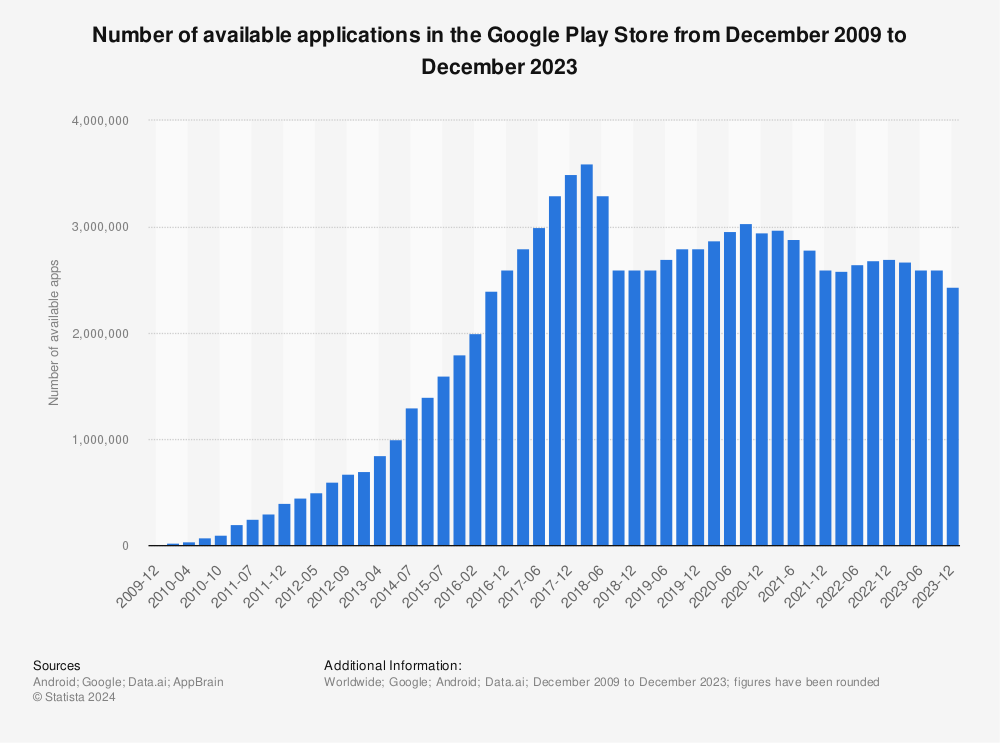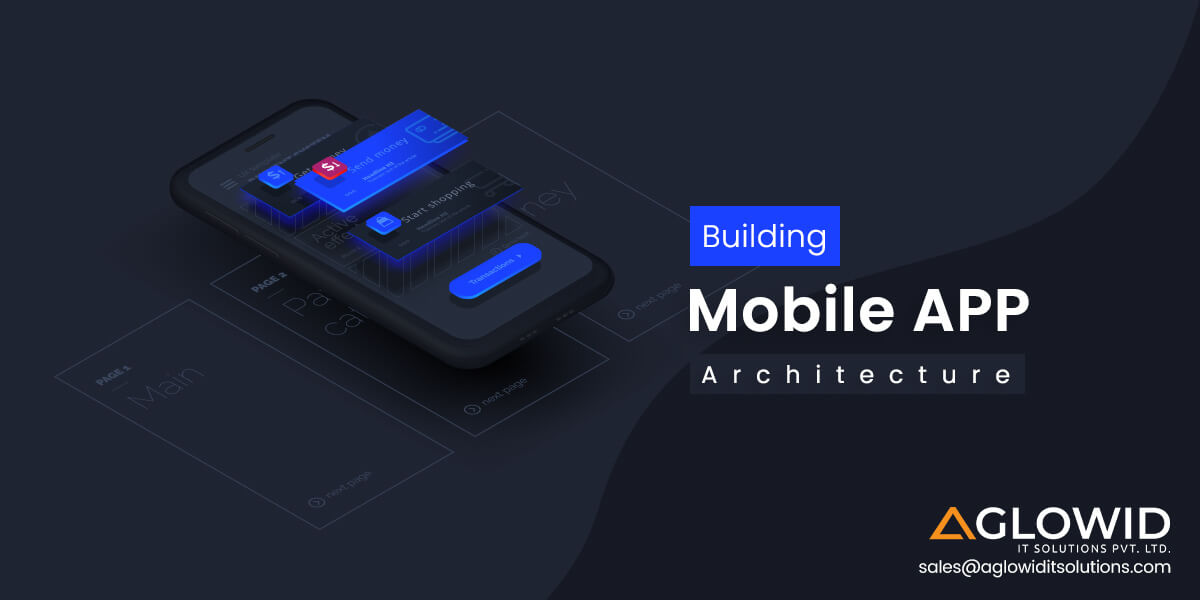Quick Summary: Any application’s lifecycle planning must include app maintenance cost into consideration. It is a necessary step for any application to succeed in today’s industry. The narrative does not end with the creation and publication of an app on the Google Play Store. The program, like a building, will deteriorate with time. The process is substantially faster with the application. However, technology, the market, and the user experience change every few months. Application upkeep is getting increasingly important.
With the rise in popularity of smartphones, tablets, and improved mobile connectivity, nearly every company is creating mobile apps to reach present and future clients.
According to Statista, there are 3.82 million mobile apps in the Google Play store and 2.22 million in the Apple App Store as of the first quarter of 2021.
These figures indicate the amount of competition in app development.
Executives eager to carve out a budget for new app development and launch may forget to factor in the app’s long-term cost. Developers understand that there is more to an application than simply rolling it on and enabling the user to enjoy it. You won’t be able to move into your new home without first cleaning and painting it, and the same should be true when it comes to application upkeep.
Why Mobile Application Maintenance Is Important?
In the long run, concentrating on app maintenance will pay off. It has been found that improving app retention rates by only 5% raises an organization’s earnings from 25% to 95%. Maintaining an app is required for survival, as each app in the store does.
Performance needs, design popularity changes, new device launches, and new operating system launches are reasons to have an app maintenance strategy in place before beginning the development process. In some words, no matter how well you build an app, you must always maintain it.
Your app’s lifespan doesn’t end when it’s finished and released to the public. You’ll now need to attract people, which means more significant server load and more accountability for your software. This is where app support and upkeep come into play.
According to Statista, over 100,000 new apps are added to Google Play every quarter.
There are many apps on Google Play and the App Store, but most of them have been abandoned or are in terrible condition. The majority of these apps are left after they are released on the market, prompting Google to remove many apps in the summer of 2018.
From November’19 to April ’20, let’s look at the graph to better understand the Abandoned app by category.

Source: Wandera
With the productivity category accounting for 38.7% of abandoned apps, it’s evident that consumers favor apps that provide them with value and utility. The productivity area is fiercely competitive, with the highest number of apps that have been abandoned.
With 30.3 percent of the total, gaming apps are the second most abandoned app category, closely following productivity apps. The high percentage is most likely because it represents a frequently withdrawn category from the Google Play Store, and it’s also the category where most people break the Play Store’s rules.
Types of Mobile App Maintenance
To put it in a few words, mobile app maintenance typically branches into the following types –

Emergency Maintenance
An emergency could occur, implying that the troubles or failures would be sudden, unanticipated, and unexpected. In such cases, you must address the issues as soon as possible while providing a flawless app experience.
Perfective Maintenance
With new or updated user requirements arising from trending mobile features and functionalities, it makes sense to proactively take feedback into account and address functional alterations in the source code, resulting in a flawless user experience.
Adaptive Maintenance
To maintain the system up to date, you’ll need to keep track of changes in the application with adaptive maintenance. You may need to make changes to your working environments, such as your operating system, hardware, or software, affecting the application’s functionality.
Preventive Maintenance
The intervention or depreciation of the incidence of errors is referred to as preventive maintenance. Through code rearrangement, optimization, and document updates, the aim is to decrease the application’s complexity and enhance the maintainability factor.
Corrective Maintenance
Repairs, malfunctions, and defects in application functions can all be taken care of via Corrective Maintenance. Errors in design, coding, and application logic are all part of the maintenance of mobile apps.
As the owner of an application, you’ll need to budget for various application maintenance charges. And if you’re working with an estimate, you’ll need to consider a variety of elements when planning your app development and maintenance budget.
How Much Does It Cost to Maintain an App?
Before diving into the detail, let’s take a look at the price range from around the globe.
PlacesCostAverage Cost
| India | $8 to $80 | $26 |
| Australia | $32 to $142 | $110 |
| North America | $10 to $225 | $165 |
| South America | $21 to $107 | $34 |
| Easter Europe | $20 to $97 | $36 |
| Western Europe & UK | $32 to $167 | $70 |

In the industry, there are a variety of viewpoints on this subject. However, the app’s complexity, the technology employed, the platform on which the app was created, and other factors all have a role. According to experts, app maintenance might cost anywhere from 15-20% of the original development cost.
Here are few factors to answer how much does app maintenance cost
- The average cost of operating an app includes content creation, promotional activities, graph design, purchasing media assets, and much more.
- Upgrading servers or using a different hosting service impacts the cost of maintaining a mobile app.
- Ongoing maintenance costs, such as code changes, new technology integration, platform upgrades, and so on.
Aside from that, there are a few other factors that could influence the cost of maintaining a mobile app:
- Servers: $(20- 60)/ month
- Push Notifications: $10/ month
- Payment Gateways: $149+/ month
- Additional unpredictable events: Depends upon the event
Factors to determine the App Maintenance Cost
Let’s take a look at factors important in mobile app maintenance is essential in detail.

Bug Fixing & Frequent Update
Updates are essential with every technology. Every app gets updated versions. These update’s costs rely on many factors. If you have a bug that should be solved in the line of code, it can cost you up to $50. Suppose you want to update the whole performance aspects that could cost $1000 to $2000. It can also rely on app size and how properly it functions.
Keep up with Latest Trends
Your program will run on Android, iOS, or both of these operating systems. You may have noticed that your device requires a restart after an update that comes every few months. This is an update to the operating system.
When customers install this update on their device, there’s a good chance your app won’t work correctly on some devices. The development business will test all of your app’s features and functionalities on a new OS to guarantee that everything is working correctly.
The app maintenance includes the whole process of updating to the most current operating system. Furthermore, an app creation company consists of this in the cost of annual app maintenance.
Upgrade UI/UX according to the latest trends
There’s a good chance you’ll alter your mind on design elements. Because the User Interface is just as vital as the functionality, you should do such. What is trendy in design, like anything else, is continually changing, and you’ll gain new ideas for making your home look more modern and fresh.
The other side of this is the requirement to make design modifications to new mobile device releases. As you may have noticed, there are various smartphones available, and both iOS and Android release new phones with varying screen sizes.
This has a significant impact on how a user perceives your software. Buttons may appear crooked or even be chopped off. Consider the iPhone X, XS Max, and XR, which all have larger screens while also having the screen surround the speaker at the top. It was necessary to update iOS apps to seem correct; otherwise, items would be restricted.
Updating Content
Your work does not end after your app is out. You must upgrade numerous aspects of your app to ensure that it survives in the mobile industry for an extended period. Images, banners, vital content, video, and so forth are all included. The elements must be adjusted based on your target demographic and the level of interaction you desire from your app.
You can contact an app maintenance staff to perform any necessary technical changes on the home screen or any other screen. The app’s ongoing maintenance fees also cover this.
Manage push notification
The Admin Panel can be used to send push notifications, which is a simple and effective operation. You can, however, hire an application maintenance company to help you implement advanced push notifications into your app.
The main question now is whether or not you require push alerts. The answer to this question is contingent on the type of application and the goals you’re aiming for. For example, if you’re running a complicated app like Amazon, you’ll get many push alerts. These alerts should be classified according to their intended use:
- Festive Offers
- Discount Offers
- Latest discounts
- Offers for wishlist products
- Latest announcements, etc
All of these push notifications should be tailored to the amount of interaction you require from your target audience as well as your long-term business objectives.
Until new trends in the tech industry are introduced, the app maintenance staff would have to make numerous updates to the program.
Application Analytics and Improvement
It’s critical to understand whether your software adds value to your company. A successful app will ensure that your company grows and that more customers are engaged. If not, you’ll need to keep track of the app’s performance and user engagement.
It’s critical to keep an eye on Analytics to track performance concerns, including crashes, malfunctions, and updates. Google Statistics, for example, is a free tool that only provides essential information on app analytics. You’ll need a sophisticated analytics tool and a technical app maintenance team to tailor that tool depending on your business needs to learn more about how well your app is performing.
Reducing Downtimes and Revenue Losses
Downtimes are nightmares that become a reality for developers if they are not planned for ahead of time. Regular upgrades, compatibility with the latest technology, protection against hacking attempts, and other measures can avoid possible downtimes. Because downtimes can result in significant revenue losses for developers, you should have a budget for app maintenance as part of your overall budget.
Which application takes the highest app maintenance cost?
Creating a hybrid app necessitates the use of a single codebase. A native app, on the other hand, will require a separate app developer for each platform. As a result, maintenance costs for native apps are higher than for hybrid apps.
Tips to Lower app Development and maintenance cost
Well, specific ways can be used to reduce the investment in mobile app maintenance. Here the recommendations are divided into pre and post-categories. Let’s take a look at them in detail for a better understanding.

Pre-Development
The following are the points that can be considered in the pre-development category that can help you reduce the maintenance cost of the application.
Selecting the proper development platform
Choosing the right platform can be the most crucial point that can affect the cost, effort, and time you will invest in the application. There are two types of app development platforms widely used at the moment.
- Native app development
- Hybrid app development
Apps that are native to a platform are known as native apps. In other words, you’ll need to create many native apps for different operating systems, such as iOS, Android, and Windows. Native programs, on the other hand, are usually speedier and take up less space once installed. These apps can also provide superior features because developers focus solely on creating programs for one sort of operating system.
Hybrid apps, as the name implies, are cross-platform applications. Building a single software for several operating systems is, of course, a time and money saver. If you want to provide limited services on different platforms, you should consider designing a hybrid app because it will save you time to manage multiple apps. Even from a long-term perspective, you are reducing your investment.
Focus on building MVP
A minimum viable product (MVP) app has only the most basic functionalities. As a result, including many unneeded features can raise the app’s size, loading time, and crash risk. As a result, it is recommended that you create an app with crucial functionality for your users.
You can later add features based on the input you get from your users. Alternatively, if your app’s performance isn’t affected, you can keep an eye on your competitors or trends and improve your app accordingly.
Post Development
Following are some of the Post Development points that will help you maintain the cost for mobile app
Analytics
Google Analytics, for example, provides a wealth of data to assist you in making the best selections for analyzing user behavior and generating reports that provide you with solutions. There are free tools accessible, but advanced tools provide more information.
It’s also a time investment because you’ll need someone to spend time applying it and double-checking everything.
Performance issues like glitches, crashes, and other faults necessitate the use of analytics. You’ll have to troubleshoot the problems as problems arise for various reasons other than the release of new OS versions.
Hosting
You must pay to have your app’s database and backend hosted for it to function correctly. There are numerous hosting alternatives available, including a cloud-based environment. AWS (Amazon Web Services) is one of the cloud services that will be less expensive because you only pay for what you use, and the server will require less setup and maintenance.
App Security
Another vital maintenance cost of an app is ensuring the security of your app. You should think about two things: legally mandated changes and continuing security optimization. To guarantee that sensitive user data is not jeopardized, developers will need to keep track of any third-party integration privacy upgrades and modifications.
It’s possible that leaving an update unnamed will result in a security breach. As a result, you’ll need to keep in mind legislative changes like GDPR, which are constantly shaking up how information is processed and safeguarded worldwide.
Third-Party
There may be a monthly fee if you use something in your app that comes from someone else. For example, if you employ licensed technology, you will have to pay the price. This is something you should talk about right away to see if there’s a way around it.
Bugs & Updates
With any technology, it’s critical to stay up to date. Every app is upgraded at some point. A variety of factors determines the expenses of these updates. If you only have a bug in a line of code that needs to be fixed, it might cost you up to $50. If you want to update all aspects of performance, expect to pay between $1000 and $2000. It may also be determined by the size of the app and how well it performs.
Marketing
To attract and keep users, you’ll require user engagement and marketing functions. There are many free things to do, but investing a little money will help you get your brand out there.
Depending on your budget and the activities you want, you can spend anywhere from $100 to $250000 on marketing. A skilled marketing team can tailor a marketing strategy to your needs and budget.
Customer Support
You must listen to your users if you want to be truly successful. Address a complaint as soon as you notice it. Someone’s attitude changes the instant they hear an answer, no matter how upset they are. More than anything, they want to be heard. Many of the most popular apps have excellent complaint response teams.
Investing in this is worthwhile because individuals who responded will almost certainly inform their friends and family. The secret to great reviews is having someone dedicated to replying to users. This will, of course, be an ongoing expense for you, and it’s not much because it can be incorporated into your existing marketing activities.
App Maintenance Best Practices to Follow
- Maintain an updated user interface
- Regularly fix the bugs
- Add in new feature updates
- Ensure the app supports new software and hardware
- Arrange scheduled system maintenance
- Keep an eye on licenses
- Monitor performance
Wrapping Up!
If you want your app to last in the mobile market for a long time, you should focus on assigning a sufficient budget for app maintenance. It’s critical to concentrate on the application’s functionality once released to gain market traction. When creating the app maintenance budget, don’t forget to include non-infrastructural costs such as third-party integrations, hosting, and servers. To maintain your app competitiveness, bear in mind the duties of your client support, developers, marketing, and QAs. Maintain the highest quality of your software so that consumers want to come back for more.
Also Check:
![How To Reduce App Maintenance Cost [Save Big Bucks]](https://aglowiditsolutions.com/wp-content/uploads/2019/10/Reduce-App-Maintenance-Cost.png)





 Say
Say